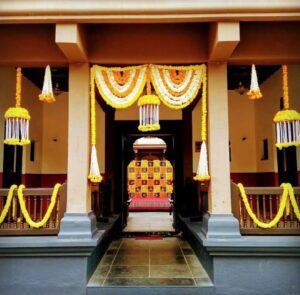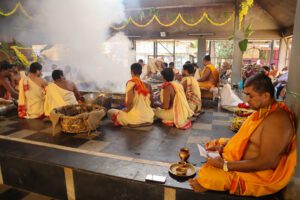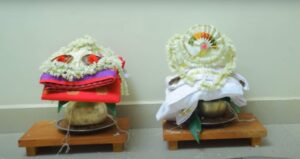This tradition takes matrimony very seriously — with a twist. The wedding it commemorates is not for the living but for the departed.

The tradition of 'Kule Madime' is unique to Tulunadu, a coastal region in southwestern Karnataka. (iStock)
The house was adorned with flowers and the guests had arrived in their finery. The kitchen bustled with activity as the women got busy preparing an array of dishes.
All this frenetic activity was due to a wedding at Pratibha Puthran’s ancestral house in Mangaluru’s Surathkal suburb. However, there is a twist to this commonplace development.
It was not a wedding of two living individuals, but two departed souls.
Welcome to the fascinating tradition of Kule Madime, unique to Tulunadu, a coastal region in southwestern Karnataka. Kule Madime translates to “marriage between spirits” in the local Tulu dialect, a language spoken in coastal Karnataka.
This function is held during the Aati month, which typically falls between July and August — a period when all auspicious activities are avoided.
When she asked her grandma about Kule Madime’s relevance, Pratibha learnt that the ceremony was conducted to provide salvation to the souls of people who died before entering the state of matrimony.
“Tuluvas pray to spirits and daivas (God-like beings), who they consider as their protectors. So, we have kutumbha (family) and grama (village) daivas. We believe that even after their death, the spirits of our family members continue to stay around us. Hence, ancestral worship is deeply ingrained in all our ceremonies and the Aati month is dedicated to our ancestors,” she elaborated.
Pratibha also found out that in addition to fulfilling any discontent longing of the dead, Kule Madime also serves as an appeasement.

Kule Madime is held during the Aati month. (Dinesh Suvarna)
Anand Bhat, a Mangaluru-based pandit, explained that when ancestors have died as bachelors and spinsters, there is a chance of hurdles cropping up in the matrimonial functions of people in the household.
Kule Madime is aimed at assuaging their ire.
“It is generally believed that the restless spirits of unmarried people can bring misfortune to other single relatives in the family or newly-wed couples trying to start their family,” Anand said.
He added, “Moreover, Kule Madime brings closure to parents who have lost their young children, as many of them start planning for their offspring’s marriage even when the child is an infant.”
While Kule Madime is symbolic, the wedding ceremonies involved are akin to the real deal.
The family of the departed groom will seek out a suitable match among deceased girls and involve an astrologer to assess the compatibility of their horoscopes for a harmonious union.
Upon obtaining a positive endorsement from the astrologer, the two families will proceed to confirm the dates for the engagement and wedding ceremonies.

The wedding is conducted as per Hindu rituals. (iStock)
After the engagement ceremony formalises the upcoming union, preparations for the wedding begin with fervour. This includes shopping for the dhaare (wedding saree) for the bride, mundu, shirt, turban, and shawl for the groom, and even gold jewellery.
On D-day (no pun intended), the groom’s family will visit the bride’s house, singing and dancing, and present the dhaare with a blouse, vadungila (wedding ring), karyamani (mangalsutra)
Then, the two are wed, as per Hindu rituals, complete with pheras and fanfare. The groom’s sister will then place the karyamani on the bride’s image.
Pratibha also learnt that while traditionally, weddings in Tulunadu are conducted during the daytime, Kule Madime is held at night, when it is presumed that spirits are most active.
Also, young children, unmarried youth, and expectant mothers are not allowed to participate in the celebrations.
Interestingly, the representation of the deceased couple varies from village to village.
In some parts of Tulunadu, families prepare statues resembling the boy or girl, while others use thick lumps of cooked rice or even coconuts to symbolise the duo.

The common practice is to use new wedding clothes as stand-ins for the groom and bride. (Dinesh Suvarna)
“The most common practice is to use new wedding clothes as stand-ins for the groom and bride. The two are placed side by side on a mane (raised wooden platform) or cloth-covered chairs. The newly-wed couple is then presented with a lavish traditional feast on banana leaves and left to enjoy their meal in peace,” Anand explained.
The guests are served the meal a few minutes after the newly-married duo has purportedly started theirs.
After offering congratulations, the bride is escorted to her new home in the avatar where she was wed.
The symbolic persona of the new couple is placed respectfully in a prominent part of the house, where relatives and neighbours visit to congratulate them.
On the second day, the bride’s family will visit her marital house to escort her back to her parental home, as tradition dictates.
Before they can take the bride back home, they will also invite the groom and his family over for lunch and dinner. All this is by the Vedic practices performed in every Hindu wedding.

The symbolic persona of the new couple is placed respectfully in a prominent part of the house. (Dinesh Suvarna)
The unique aspect is that the couple is present, only in spirit, throughout it all. And at the end of all these ceremonies, they find themselves immersed together either in the village or temple pond, to help them continue their happy marital journey in the astral plane.
A solution has also been offered to families unable to find a suitable match for their deceased child who has reached a marriageable age.
A collective Kule Madime is held near Koodli Lord Janardhana temple near Udupi, where the pandits of the temple conduct all the rituals. The institution of marriage is taken extremely seriously by the people of Tulunadu, where weddings hold a special place in the community’s social fabric.
While Kule Madime might astonish many and even sound absurd to others, for Tuluvas, this is how they pay their respects to their dearly departed.

Jul 27, 2024

Jul 26, 2024

Jul 26, 2024

Jul 26, 2024

Jul 26, 2024

Jul 26, 2024